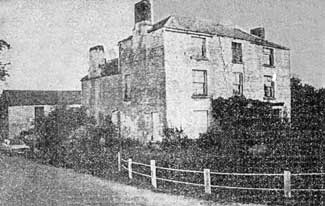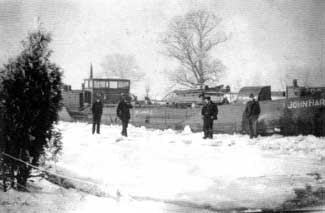 Parkend
Bridge House Parkend
Bridge House
I was born in
the bridge house at Parkend Bridge in 1941 and lived there until
1955. My father Bob Woodman was the bridgeman, responsible for looking
after the bridge and opening it to canal traffic, which was very
busy in those days, passing by at all hours of the day and night,
weekends included. He was the only bridgeman on the canal to do
war service in the armed forces; during his absence, my mother Joyce
took over as bridgekeeper.
The
photo shows Bob and Joyce in front of the house with one of the
portico colums on the left. Behind Bob can be seen a bush cut into
the shape of a cockerel, and on the wall behind are the drags -
used for recovering bodies from the canal.
 Castle
Inn Castle
Inn
The bridge was always
known locally as Castle Bridge, and our house, in Castle Lane, as
Castle Bridge House. Nearby, in those days, stood the Castle Inn.
This was a very large three storey building with cellars, stable
blocks, courtyard and outbuildings. Pieces of broken clay pipes,
mainly the bowls, were often unearthed along with old beer bottles.
The inn has now been demolished and a new smaller Castle House built
in the grounds. The original "castle" (which may have
been only a large hall) was less than three quarters of a mile away
across the fields behind Moreton Valence church. The deep moat can
still be seen.
Passing Traffic
I remember
the longboats travelling up the canal en route to Bournville with
the unprocessed chocolate on board. Sometimes a few hard lumps of
it would be thrown on to the canal bank when we opened the bridge.
It had a wonderful taste and was very much appreciated, especially
when sweets were on ration. Other "bits of cargo" also
came our way in exchange for eggs, milk, meat and so on. We always
seemed to have one Channel Island cow plus many pigs, poultry, geese,
ducks and other stock. They lived on the canal bank usually, but
even the pigs liked a bath sometimes!
 Ice on the Canal Ice on the Canal
The harsh winter
of 1947 brought canal traffic to a halt at the bridge. The ice proved
too thick for the tankers heading fully laden up the canal. They
all came to a stop after the first one had passed through. Consequently,
the bridge could not be closed again for road traffic to cross.
Some of the crew left the petrol tankers and walked on the packed
ice. Eventually the steam tug Speedwell (sister tug to the Mayflower)
forced a path through the ice to Gloucester.
Flooding
In March, after
the snow and ice, came the floods, which swamped the ground floor
rooms of our home, forcing us to live upstairs for six months. The
house being built into the embankment, there was still access on
to the canal bank from the upstairs rooms. With the fields and road
either side flooded, our only way to a local shop was by going up
the canal towpath for nearly two miles. We were flooded again in
1950. I understand the Bridge House was yet again flooded in 2007,
when the canal overflowed. |